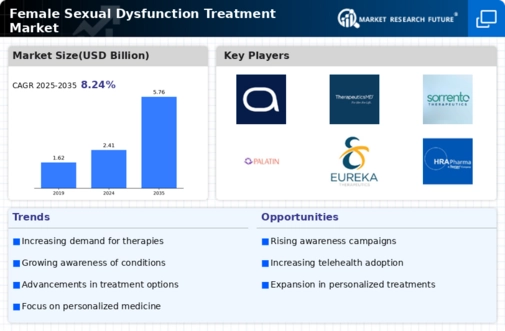Increased Focus on Mental Health
The growing emphasis on mental health is a crucial driver for the Female Sexual Dysfunction Treatment Market. Mental health issues, such as anxiety and depression, are often linked to sexual dysfunction in women. As awareness of the connection between mental well-being and sexual health rises, more women are seeking comprehensive treatment approaches that address both aspects. This trend has led to the development of integrated treatment plans that combine psychological support with medical interventions. Consequently, healthcare providers are more likely to offer holistic solutions, thereby expanding the market for female sexual dysfunction treatments.
Advancements in Treatment Options
Technological advancements in treatment options are reshaping the Female Sexual Dysfunction Treatment Market. Innovations such as pharmacological therapies, hormonal treatments, and non-invasive procedures are becoming more prevalent. For instance, the introduction of new medications targeting specific sexual dysfunctions has expanded the therapeutic landscape. Additionally, devices designed to enhance sexual function are gaining traction. According to recent data, the market for female sexual dysfunction treatments is projected to grow at a compound annual growth rate of over 5 percent in the coming years. This growth is indicative of the increasing acceptance and availability of diverse treatment modalities.
Telehealth and Remote Consultations
The rise of telehealth services is transforming the Female Sexual Dysfunction Treatment Market. Remote consultations provide women with greater access to healthcare professionals, particularly in areas where specialized services may be limited. This convenience encourages women to seek help for sexual dysfunction, which they might otherwise avoid due to stigma or logistical challenges. Telehealth platforms are increasingly incorporating sexual health services, allowing for discreet consultations and follow-ups. As a result, the market is likely to see a surge in demand for treatments, as more women feel empowered to address their sexual health concerns through accessible and confidential channels.
Rising Prevalence of Female Sexual Dysfunction
The increasing prevalence of female sexual dysfunction is a primary driver for the Female Sexual Dysfunction Treatment Market. Studies indicate that approximately 40 percent of women experience some form of sexual dysfunction during their lifetime. This growing recognition of the condition has led to heightened demand for effective treatments. As awareness spreads, more women are seeking help, thereby expanding the market. The rise in conditions such as hormonal imbalances, psychological issues, and chronic illnesses contributes to this trend. Consequently, pharmaceutical companies are investing in research and development to create innovative therapies tailored to women's needs, further propelling the market forward.
Evolving Attitudes Towards Female Sexual Health
Changing societal attitudes towards female sexual health significantly influence the Female Sexual Dysfunction Treatment Market. As discussions surrounding women's health become more open and accepted, women are increasingly willing to seek treatment for sexual dysfunction. This cultural shift encourages healthcare providers to prioritize female sexual health, leading to the development of specialized clinics and treatment options. Furthermore, the integration of sexual health into general healthcare practices fosters a more supportive environment for women. This evolving perspective not only enhances the visibility of female sexual dysfunction but also drives market growth as more women access available treatments.

















Leave a Comment